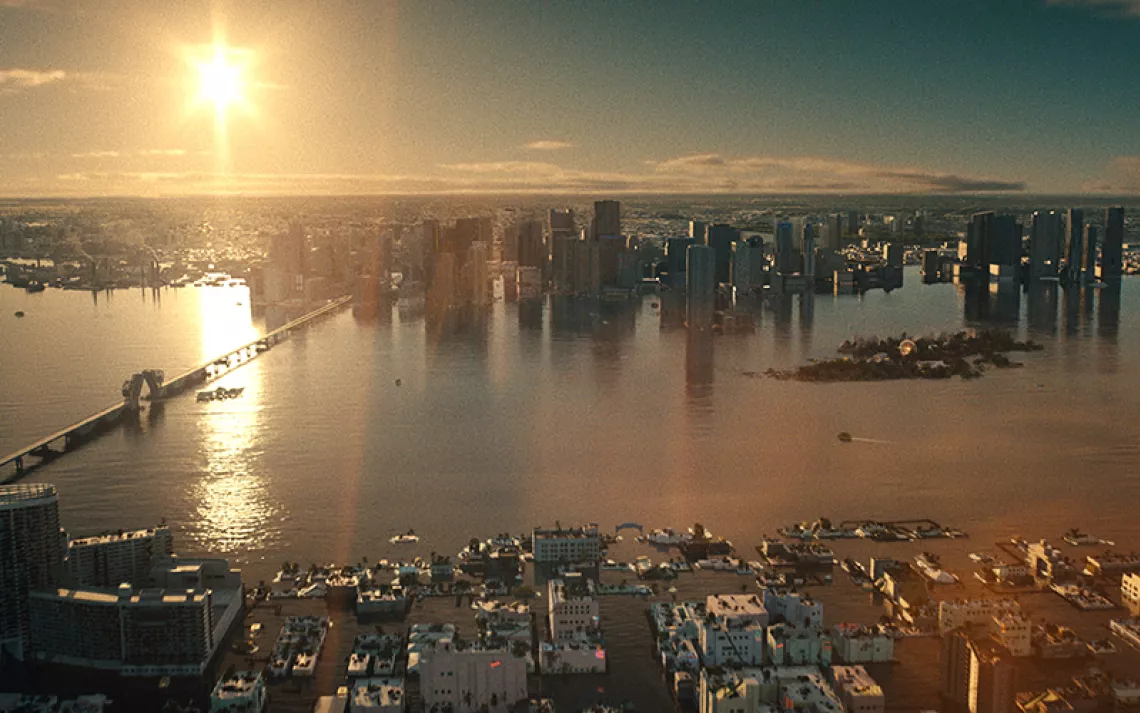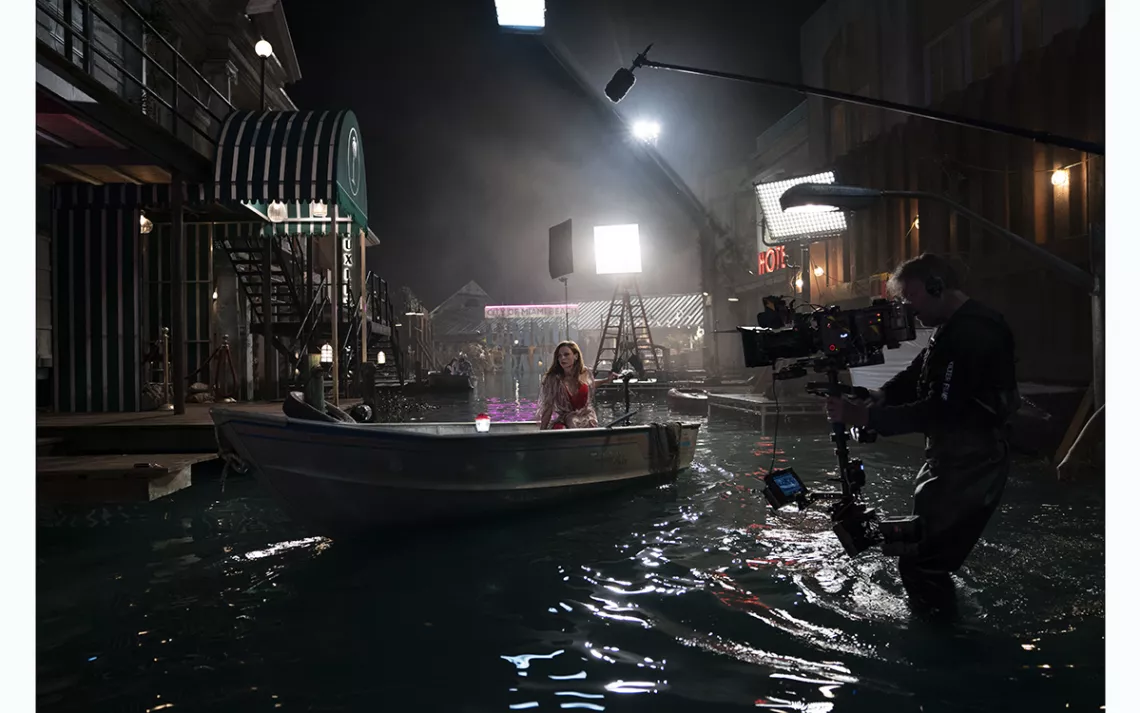Does Future Miami Really Flood Like That?
Fact-checking the climate noir "Reminiscence"

The flooded Miami of Reminiscence | Photo courtesy of Warner Bros. Pictures
Movies that give any mention of global warming are rare. As a person who cares about both film and the end of the climate that we have come to know and depend on, I’m always searching for signs of even the tiniest overlap between the two. My heart leaps at news of any new weather-related apocalyptic feature, even if the result is, say, a deeply loopy, scientifically implausible allegory of class warfare that makes literally no scientific sense (Snowpiercer) or a thrill ride that never mentions climate change once but is coy enough to let you see whatever you want to see (Mad Max: Fury Road).
But there’s been something about the past few years that has made me less patient about these crumbs. It could be the fact that the six-largest wildfires in California’s record books happened in the past two years, or that of the past eight years, five have been the warmest in US history, or that July 2021 was the hottest month ever recorded (the records in question date back to the 1880s—the Paleocene-Eocene Thermal Maximum was obviously hotter). The time for vague allusions is over, and the hour is nigh for movies to put a little more work into building out the specifics of their future climates.
This is the first of a series fact-checking the science and politics of different climate-related films. This first installment was inspired by reading Disposable City (Bold Type, 2020) by Miami-based journalist Mario Alejandro Ariza, shortly after watching Reminiscence, the flooded-future-Miami sci-fi noir from filmmaker and Westworld co-creator Lisa Joy (released this summer, currently streaming on HBO Max).
In an interview with science fiction author Charlie Jane Anders, Joy said that while she didn’t want to make Reminiscence about climate change (the plot of the film is a pretty standard “What’s up with that mysterious dame?” potboiler), Joy did want to show its effects. “I wanted this to be matter-of-fact. I’m not even going to discuss it: The waters have risen.” She adds:
In the film, we consciously put way fewer cars on the streets. We dealt with architecture in a way that shows how you can blockade some of the waters and turn a lot of the energy sources to solar panels. But you can also see it’s pretty late in the game when we’re doing it, and a lot of people have suffered, and there are still inequalities in the way that dry land is doled out.
As soon as people wrap their heads around the idea that this is the new reality, Joy concludes, maybe then they will start asking how to stop it.
Maybe? Or, audiences could just take it as a sign to write off Miami as a doomed city. Who’s to say? That’s not the question we’re here to ask. That question is, Just how scientifically and politically realistic is Reminiscence?

Actor Rebecca Ferguson on the set of Reminiscence. | Photo courtesy of Warner Bros. Pictures
It’s so hot outside that people mostly come out at night.
Fact check: Definitely
According to a study published in Nature Climate Change, by 2100 Miami residents will be living through between 100 to 200 deadly heat days a year (“deadly heat” is calculated according to not just temperature but also humidity, so weather can hit deadly heat before temperatures break 100°F). Doctors in Miami are already reporting a rise in health problems in residents who can’t escape the heat.
What’s less certain is that a protagonist like Hugh Jackman, who wears a button-down shirt and long pants through most of the film, could do so without sweating through both and promptly fainting. Climate projections show very clearly that without eliminating almost all carbon emissions, the Miami of the future will be an unwelcoming place for classic noir film fashion.
Meanwhile, in the Anders interview, Joy gets rhapsodic about this aspect of dystopian Miami and its uses as a plot device. “In old noir, darkness is when things are bad.… In this world, darkness is when people can actually go out and live their lives, because it’s so damn hot. Crime and true darkness—moral darkness—happens in the searing light of day.” In the Miami of the future, though, darkness may not be much of a reprieve during heat waves, since nights are warming faster than days across the globe.
Parts of Miami are so flooded that Hugh Jackman can have a whole fight scene in an underwater concert hall.
Fact check: Dubious
The kind of sea level rise that can permanently flood the entire ground floor of a concert hall is higher than the most extreme climate projections for Miami—at least by 2100. But, as Mario Alejandro Ariza writes, the most likely sea level rise by 2100 is five or six feet—not enough to flood a concert hall, but far more than the necessary to threaten the viability of Miami’s drainage system (six inches) or render hundreds of thousands of septic tanks across Miami-Dade County unusable (two feet). In this future, Hugh Jackman may not be underwater, but he will have a bacterial infection and microscopic dinoflagellates.
There are solar panels everywhere.
Fact check: Please let it be so
Florida is consistently ranked as one of the best states in the US as far as potential for solar deployment is concerned—there’s just so much sun that its nickname in solar circles is “The Sleeping Giant.” It’s also been consistently ranked as one of the worst cities for solar as far as politics are concerned.
Things are changing. Florida Power and Light blew up its last coal plant earlier this year and replaced it with a solar center. But utilities and legislators still work together to make small-scale solar as unappealing as possible to ratepayers.
That said, there’s no mention of utilities even existing in Reminiscence, and it’s hard to imagine all that electrical infrastructure still working under all that seawater. So maybe this future Miami’s off the grid?
Miami is surrounded by sea walls that protect the inner ring of the city from the ocean.
Fact check: Nice try
Miami does have seawalls and pumps to send the water behind them back out to the ocean. The Army Corps of Engineers is proposing building even more. But these mostly serve as protection from storm surges. Miami is built on ancient limestone that is riddled with tiny holes—a geologic setup that is often compared to swiss cheese. As Leonard Berry, professor of geosciences at Florida Atlantic University, told the Senate Energy Committee that flood barriers are too expensive and impractical under these circumstances—the water that you’re trying to keep out will rise up out of the ground, the way it already does during sunny-day floods.
The rich and powerful seize all the dry land for themselves.
Fact check: Already happening
Miami already has the third-highest income inequality in the US (after San Juan, Puerto Rico, and Atlanta, Georgia). During the financial crisis of 2008, writes Ariza, 30 percent of the Haitian homeowners in Miami’s Little Haiti neighborhood lost property, partly due to predatory mortgages with bad terms and a temporary collapse in real estate values. If those owners had been able to refinance those mortgages, they might have been able to hold onto that property long enough to see land values rise again—instead, speculators, seeing cheap real estate at an almost-unheard-of-for-Miami 15 feet above sea level, swooped in and began building developments that the current locals couldn’t afford to live in. Similar stories are playing out in Liberty City (8.5 feet above sea level) and West Coconut Grove (10 feet above sea level).
As Ariza writes in Disposable City:
If Miami survives, it will be a place where high-density mixed-use development crowds the high ground of the Atlantic Coastal Ridge, a thin line of ancient coral reef with a mean elevation twice that of the surrounding drained swampland. Instead of maintaining the low density, “everything is 15 minutes away by car” suburbs, Miami will have to transition to packed neighborhoods connected by efficient public transit.
In other words: It doesn’t have to be this way. Miami may be right up there with New Orleans and New York City as the star attraction of climate dystopias, but it can—and and hopefully will—write its own story.
 The Magazine of The Sierra Club
The Magazine of The Sierra Club



